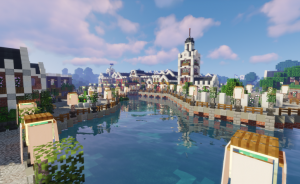The PCB wiki has now been archived and is read-only. |
Tulpfloerdam
Tulpfloerdam, officially know as "Het Koninkrijk van Tulpfloerdam" or "The Kingdom of Tulpfloerdam", is a city-state nation located in the Northern part of the 1.15 map. Tulpfloerdam was the 3rd city on the 1.15 map to gain warp status (Following Montmorency and applying for warp the same day as Dixieville). The city is a Dutch city with heavy inspiration from Amsterdam, Haarlem, and Den Haag (The Hague).
History
In February of 1632, Dutch explorers were venturing through what is now modern day Dixieville and towards Titania and Eire. These explorers had faced many hardships crossing the swamplands/wetlands of now a days western Cascadia. Eventually, these men found a small deciduous forest sandwiched in between Mountains, Swamp, Dark Oak Forests, and Plains. The valleys of this forest had many rivers and small mountains. In the heart of this forest lies a lake, abundant with flowers. This gave the forest the name it knows today, "Woudbloemen" or "Forest Flowers".
Beginnings
After finding the shallow and flat shoreline perfect for agriculture, these settlers set up a resting camp for anyone else who passed through the land. Little did the Dutchmen know, the river that feeds the lake has incredibly violent flooding periods. Every 20 years, water levels rise higher than usual. These explorers landed themselves at the 20 year interval. Come mid April and the lake breached the shore, washing away and flooding the settlement they had made. These Dutchmen refused to leave this lake valley, so they built a dam that they would use to regulate the water flow into the lake.
Early Life
Once the dam was built, the lake was finally safe from future floods. These men had sent letters back to the mainland Netherlands in hopes they could send women over to start a growing population. Women arrived the following year, along with animals, seeds, tulip bulbs, and letters from the king and families. Small houses were rebuilt in the same location as the previous houses that were washed away. The population boomed from just 12 men to about 75-90 people in 1634. By the year 1640, the population was already at 600.
Cityhood
As this settlement continued to grow, so did its autonomy. The people had no name to call this place and yet were a major part in travel in the northern world. People petitioned to name the city "Woudbloemen" after the forest, but another very strong candidate was creeping up. This new name was "Tulpenbloemdamme", which translated to English would mean "The Dam of the Tulip Flowers". A community poll was made and Tulpenbloemdamme won by a small lead. Thus, on May 28, 1653, the City of Tulpenbloemdamme was established with Thijs Meijer being the first mayor of the city.
The Kingdom of Tarlia
This quite town, nestled in the hills of the Woudbloemen, had changed very little. After 3 to 4 generations of Tulpen citizens, the name went from "Tulpenbloemdamme" to something closer to what you hear nowadays, "Tulpefloerdamme". The city of Tulips would be forever changed after being captured by a bigger kingdom. The Kingdom of Tarlia marched their way through the hills and valleys of the Woudbloemen, eventually reaching Tulpefloerdamme. The Tarlish military came through, ransacking the city and killing Tulpen citizens. The current mayor was in shock to see his city and his people die in front of him. As quick as possible, mayor Jean van Derijk signed over the city to Tarlian rule, ending the sovereignty of Tulpefloerdamme.
The Dark Ages
After the surrendering of Tulpefloerdamme of 1747, the city and its people fell into someone the darkest years the Woudbloemen had ever faced. Male Tulpen citizens were sent off into the Tarlish military. The lack of men caused the population to drop significantly. The name one again changed from "Tulpefloerdamme" to its current name "Tulpfloerdam". This change happened due to the language shift from Dutch to English as Tarlia was an English-speaking nation.
The Great Flood of Tulpfloerdam
April 13, 1794. A massive inland storm had been forming west of Tulpfloerdam over the Alga Straight. The wind patterns moving Eastward brought the storm towards Tulpfloerdam. The storm was already taking a huge toll on the city of Kingsport and was expected to maintain its strength until reaching the modern-day suburb of Stacy, Dixieville, Cascadia. The city had been notified in advanced to make sure they stay safe. The storm had reached the city by about 1 o'clock in the afternoon. The water level in the canals rose as the wind billowed through the streets of downtown. The water level had breached the walls of the canals and flooded the streets of downtown Tulpfloerdam. The old city hall and the old court house had been washed away by the flooding. The Rivier-Rozen docks, now apart of the University of Tulpfloerdam, had also been washed away in the river floods. 78 people drowned trying to flee the lower lying downtown area, this included 3 infants and 15 children.
The Dutch Return
The Kingdom of the Netherlands had heard of the conditions of one of their former settlements and sent Dutchmen onward to revive the once independent city. Upon arriving, they witnessed famine, crumbling buildings, and crime ravaging through the city. These few Dutchmen helped rebuild the city hall and and bring peace to Tulpfloerdam. Along with bringing the beauty back to Tulpfloerdam, they brought along laws, customs, and tradition that had been cutoff from Tulpfloerdam for over 100 years. These men brough legalized prostitution to Tulpfloerdam. They also brought Clogs, Ayushism (server-based religion), and more tulip bulbs.
Revolution
After the mainland Dutchmen had gone back to the Netherlands, the Tulpen citizens had been boiling up with rage and anger. The Tarlish givernment helped very little in the rebuilding of Tulpfloerdam and the citizens took that to heart. The citizens than started their own monarchy, with the first king being the current city mayor Henrich Leeuwen. After about 60 years of unsuccessful protesting and referendums, the citizens stormed the city hall on June 5, 1867; which was at the time run by the Tarlish government. Two weeks of protesting finally ended after the people demanded the ,at least ,semi-autonomous recognition of Tulpfloerdam. Tarlia signed over most ruling to the Tulpfloerdam Monarchy. Now on each June 21, Tulpfloerdam celebrates its "Onafhankelijkheidsdag" or "Independance Day".
"De Grote Opwekking"
This era of Tulpfloerdam history saw major progression. "De Grote Opwekking" translates to "The Great/Grand Revival", signifying the comeback of Tulpfloerdam. With more open laws regarding trade and foreign business, Tulpfloerdam flourished in the international scene. Tulpfloerdam also was, and still is, one of the main PCBRail hubs that connects from as far east as Montmorency and Portland, all the way to Albadia, Tulu, and TsʔIllahe in the central-west. This didn't just help benefit Tulpfloerdam, but It made trading in the west a lot easier as Tulpfloerdam was still considered Tarlish territory.
Tarlia to Corallium to Full Independance
In May of 2020, the Kingdom of Tarlia was absorbed by the once Kingdom of Corallium (now the Republic of Corallium). Tulpfloerdam then became a semi-autonomous region of Corallium. This Corallish ruling would come to a short end. On May 15, 2020, Tulpfloerdam held a referendum to be fully independent as they didn't feel connected to mainstream Corallish culture. On May 17, 2020, King Joe (Jmvvana) of Corallium signed over full ruling of Tulpfloerdam to the current ruling King of Tulpfloerdam, King Tot.
Modern Times
Tulpfloerdam, while having a long and tragic past, has thrived in the 21st century. Being reliant on foreign investment and trade, Tulpfloerdam is seen as one of the most friendliest and workable countries on the map. People come from far and wide to visit the city and its historic Downtown, Kathedraal Zuigen, University of Tulpfloerdam, and many more locations. Tulpfloerdam has very close ties with neighboring Cascadia and ships flowers off to Portland, Cascadia as thank you gifts for protecting Tulpfloerdam and being a close ally.
Miscellaneous History
World War II and the Bavarians
In World War II, Germans that tried to flee their country couldn't go anywhere in Europe. Most of them fled to the Americas, which has different cultures set with different values and languages. While there is a large German diaspora in the Americas, there is a small group of Bavarians that got on a boat and journeyed into a land of mystery, wonder, and beauty. The first group of Bavarians arrived in Tulpfloerdam at the beginning of the war in 1940. At the end of World War II, about 120 Bavarians had landed in Tulpfloerdam. These German-speaking people had a hard time integrating themselves into a city that had lost its identity years ago. A mix of Dutch and English made it hard for the Bavarians to understand what was happening. Most of these Bavarians lived near each other and formed the "Stad-Beieren" or the "Bavarian Town" of Tulpfloerdam. There was an entire block of Bavarian owned shops, restaurants, and houses near the Parliament House. Sadly, a group of Anti-Immigration Rioters set ablaze to Stad-Beieren in March of 1954. These rioters were never caught.
In the 1960's, the Tulpfloerdam government helped rebuild Stad-Beieren in a Bavarianesq Style. Nowadays, the remaining Bavarian-Tulpen community its known for actively participating in the Tulpfloerdam food scene, opening and expanding Dutch-Tulpen food palette. With Bavarians being apart of Tulpfloerdam history for some time, German (Bavarian Dialect) is now openly available and is a popular foreign language schoolkids take.
Information
Some information about Tulpfloerdam
Established: June 21, 1867
Current Ruler: Konin Ij van Dürer (Born 1991 in Vienna, Danube, URC. Assumed the throne on April 25, 2020)
National Anthem: "Tulpfloerdam"
Language(s): Dutch (Tulpen Dialect), English
Nickname: "Land van de Waterbloemen" ("Land of the Waterflowers")
Motto: "Voor altijd met één" ("Forever with One")
Religion: N/A (Ayushia/Ayushism is the dominant religion)
Owner: Totqlity (Tot)
Warp: /warp Tulpfloerdam
Warp Approved By:
- Vexnorz (July 6th, 2020)
- Ramona/Cabal (July 6th, 2020)
- Mannriah (July 7th, 2020)
Places of Interest
Downtown Tulpfloerdam: Historic canals, Small cafe's for good eats, great place for people-watching, the birthplace and origin of Tulpfloerdam.
Kathedraal Zuigen: Translates to "Cathedral of Suck (Up)". Originally Ayushian church that burnt down, Converted to Borborist while under Tarlian rule, reverted back to Ayushian in 1893.
Zuidelijk Tulp Veld: Translates to "Southern Tulip Field". Largest public Tulip Field in Tulpfloerdam. Located behind the City Hall and Courthouse.
Tulpfloerdam Theater: Oldest theatre on the map. Use to be the old courthouse until a fire broke out and detroyed the interior.
Woudbloemen National Park: Explore the southern Woudbloemen. Follow the trails to different key sites. Home to Ogalahlah Krater
Nieuw Holland National Monument: Old fortress built by the Dutch.
Huishoudstergebouw: Translates to "Housekeeper Building", Tulpfloerdam Parliament House
International Agreements
Tulpfloerdam currently has three "Sister City Agreements"
Tulpfloerdam is one of the founding members of the United Nations
Other founding members:
- United Republic of Corallium
- Cascadia

